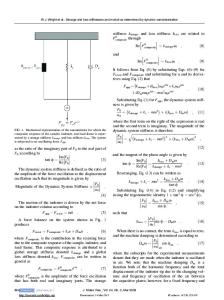Mechanical properties of nanophase TiO 2 as determined by nanoindentation
- PDF / 1,192,488 Bytes
- 10 Pages / 593.28 x 841.68 pts Page_size
- 14 Downloads / 353 Views
R.W. Siegel and A. Narayanasamya) Materials Science Division, Argonne National Laboratory, Argonne, Illinois 60439
W. D. Nix Department of Materials Science and Engineering, Stanford University, Stanford, California 94305 (Received 14 November 1989; accepted 22 January 1990)
Nanoindenter techniques have been used to determine the hardness, Young's modulus, and strain rate sensitivity of nanophase TiO2, which is currently available only in very small quantities and which cannot be tested by most conventional techniques. Hardness and Young's modulus both increase linearly with sintering temperature over the range 25-900 °C but come to within only 50-70% of the single crystal values. Strain rate sensitivity, on the other hand, is measurably greater for this material than for single crystal rutile, and the value of strain rate sensitivity increases as the grain size and the sintering temperature are decreased. In its as-compacted form, the strain rate sensitivity of nanophase TiO2 is approximately a quarter that of lead at room temperature, indicating a potential for significant ductility in these ceramic materials. Finally, a significant scatter in hardness values has been detected within individual nanophase samples. This is interpreted as arising from microstructural inhomogeneity in these materials.
I. INTRODUCTION
Nanophase ceramics are characterized by an extremely fine grain size (=5-12 nm) and exceptional purity. Numerous microscopic and spectroscopic techniques have been applied to these oxides to quantify better the ultrafine structures which are present. Discussions of grain size, phase type, void sizes, and intragrain defects are readily found in the literature.1"7 It is unfortunate, however, that aside from Vickers hardness, few mechanical properties determinations have been performed on nanophase ceramics. One would certainly expect such a fine-grained material, with such a large proportion of grain boundary area, to display quite interesting (and potentially very useful) mechanical characteristics. This paucity of data arises from the fact that nanophase materials are produced in mere milligram quantities, and thus the small sample size (=9 mm diam by 0.2-0.5 mm thick) prohibits the use of most conventional mechanical testing procedures. Nevertheless, with the advent of nanoindentation testing techniques, it is now possible to determine hardness, Young's modulus, and strain rate sensitivity for very small samples, including those of nanophase ma-
""'Permanent address: Department of Nuclear Physics, University of Madras, Madras, 600 025 India. J. Mater. Res., Vol. 5, No. 5, May 1990
terials. The following study describes the results of nanoindenter experiments for nanophase TiO2. II. EXPERIMENTAL A. Sample preparation
Nanophase TiO 2 specimens were produced at Argonne National Laboratory using a gas condensation process very similar to that pioneered for nanocrystalline metals by Birringer, Gleiter et al.1'2 Details of the nanophase sample preparation (via Ti powder condensation, oxidation, and in
Data Loading...









